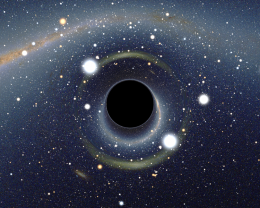February 10, 2010 report
Fall Into A Black Hole At The Speed Of Light With New Simulator

(PhysOrg.com) -- Black holes are my constant companions, at least in my imagination. Starting back a couple of decades ago, two sets of basketball tickets disappeared into one of them, and since then a pair of ski gloves, a gold ring, and more CD’s than I can count were sucked out of my hands in the same way.
Not too many of us have actually seen a black hole, but Thomas Müller, physics student, and Daniel Weiskopf, computer science professor, at the University of Stuttgart, have programmed a vision for us. With their simulation of a black hole in space, you can really imagine what it would be like to be in the pull of one.
A black hole occurs from the huge gravitational force of an exploding star. The force is so strong and dense that nothing can escape it, not even light. In fact, the enormous gravitational pull of the black hole would seem to displace the surrounding stars, creating dynamic and dramatic changes in, let’s say, a constellation. This effect is explained by the Schwarzchild black hole.
The Müller/Weiskopf simulation, detailed in the February 2010 issue of the American Journal of Physics, shows what happens to stars as they approach the black hole. In the video below, you can see the large stars of the constellation Orion seemingly split into two, mirror images of each other on opposite sides of the black hole.
As you look into the dark boundary of the hole, or the event horizon, you can see that the stars change colors, appearing redder, as the energy is sapped out of the star’s photons passing near the event horizon. But if you freefall towards the black hole, which the simulator allows you to do, the stars turn bluer due to the Doppler effect. Once in the center of the black hole, there is just the sight of a dazzlingly bright ring that appears to be circling the universe.
The Müller/Weiskopf simulation program obtained its data from about 118,000 stars mapped by the European Space Agency's Hipparcos satellite. Once you download the program, you can see the effects of a Schwarzchild black hole on any constellation or grouping of stars you like.
But keep your CDs far away from your computer screen.
More information:
-- American Journal of Physics paper: scitation.aip.org/getabs/servl … vips&gifs=yes&ref=no
-- Thomas Müller page: www.vis.uni-stuttgart.de/~muelleta/IntBH/
-- New Scientist www.newscientist.com/article/d … ss&nsref=online-news
© 2010 PhysOrg.com


















